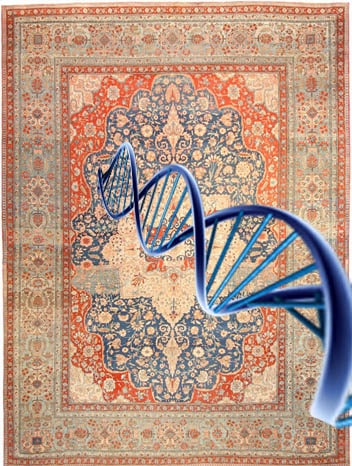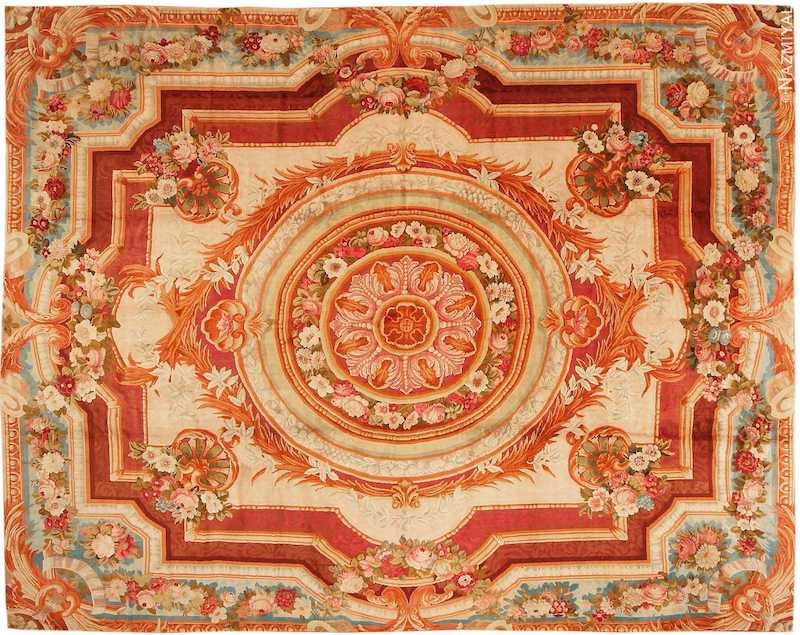Antique Carpet DNA – A Guest Blog by Wilbur Pierce
The unshaven man stood on a boulder looking up at the cave ceiling. The women’s name was Gryt and his name Grunt. He listened to her instructions, for they were husband and wife. As he was married, he did nothing right. He kept dropping his bearskin loincloth to his knees as he lifted his arms to draw and pulling them up; she scolded him for not wearing his belt. She saw the full moon. In the distance, wolves wailed and she laughed. He kept reaching toward the top the cave and making pictures. Together, they decorated the vault and marked the rock face with charcoal that she had just pulled out of the fire. Adding some color from a red rock that man later learned was iron, he scraped a blue rock that had copper in it and made a third color. He stepped back pleased as deer appeared on the walls of his home. Gryt smiled and Grunt went to bed.
Grunt’s and Grynt’s DNA traveled along strands of X and Y chromosomes linking them to a woman from Central Asia who twisted fibers making a carpet known as Pazyryk, the most ancient known – two thousand three hundred years old.. Grunt and Grynt pounded minerals into power and dyed the fleece of their sheep and from it spun wool with which they learned to weave in Penelope’s frames and Homer’s pentameters.

They were cousins, grandfathers, grandmothers, uncles and aunts to the women of Persia, Turkey and the Caucasus, who made blankets to protect themselves from the frigidity of the steppes and the desert’s nighttime chill. Grynt wove saddlebags for camels and blankets for the caravanserai – the Holiday Inns of the Middle Eastern Silk Road.
In Cathay, while Peking was ducking the Mongol Hordes, Grynt coddled worms and cocoons and pulled a fine fiber that was treasured more than gold, spun into fabrics and woven into rugs for the Imperial Palace and traded along the Interstates of Asia Minor.
When in 711, the Moorish commander Tarik crossed the Pillars of Hercules into Spain, he carried with him a vast selection of carpets. History named the big rock of the Mediterranean Jebel al Tarik “ Gibraltar “ or Tarik’s Tower and, he by this invasion opened the Iberian carpet industry which eventually migrated into France. Caliphs, Pashas, Emirs and the Sublime Porte’s of the Levant from Phoenicia to Samarkand would for centuries weave their gardens, prayers, mosques, Kufic script, flowers, cedar trees, and serif’s into the rugs that made the desert bloom.

The Pillars of Hercules.
The weaver‘s craft became the weaver’s art and the woolen designs decorated the floors of tents and the halls of palaces. The cave design eventually became a hunting carpet as rugs expressed daily life, hopes and aspirations. Designs became associated with tribes and the cities, towns of villages took on their own style so today, we can buy a Khotan, Kerman, Bakhtiari, Aubusson, Agra, or Peking, each inducted into the carpet Hall of Fame.
By Europe’s medieval period, drafty caves and castles with their stone battlements needed hangings to insulate the royal derrieres from cold winds. Damp and dank stone offered protection against slings and arrows, but sent chills down the spines of its denizens, so the tapestry was created. When Grunt and Grynt became nobles, they showed how rich they were by weaving gold thread into these wall hangings and when they ran out of money, they drizzled the tapestries by pulling the gold out of them to pay debts or hire armies. The Grunts and Grynts at Gobelin were not only artists; their product was employed as HVAC – heating, ventilation and air-conditioning in a very non-polluting solution that was as beautiful as it was effective. But the floors were cold too and carpets gave warmth.
Grunt’s DNA is directly linked to a child in France who wove French Aubusson carpets below ground by the river Creuse where it was damp and where the wool was pliable, but the conditions so unhealthy that tuberculosis was heard in every cough. He was also the ancestor of a weaver at the Soap Factory or Savonnerie who executed designs for the Le Roi Soleil to decorate the palace at Versailles. While the King had Savonnerie, the bourgeois needed its own rugs at Aubusson. But while only the King could have plush rugs, the merchant class and nobles lived with flat weaves.
Eventually, European carpet entrepreneurs like Ziegler sent designs to the weaving tribes of the Middle East to satisfy European tastes. Just as Soap Factory Carpets were made only for the king, Aubusson was founded to provide carpets for the bourgeoisie. Ziegler now made it possible so that speaking French was not necessary to decorate your home with a rug of sophisticated design. Now the king had his carpets, the nobles had theirs and the bourgeois enjoyed an artful floor.
But, until the Industrial Revolution, the weaver’s art was in the nimble and graceful fingers of women for the most part and a few men who rose to prominence in signing their carpets, much like Manet, Monet, DaVinci, Utrello, Titian or Kermani. Designs trumped quality and machine made replaced handmade while the love of the quality handmade originals remained the province of people with refined taste. Grynt and Grunt laid Oriental carpets in their manor house.
Although it appeared that automated weaving machines of Axminister would give the ax to the hand woven industry, instead it made rugs and carpets available to all people, rich and poor alike, potentates and plebeians. Like a newspaper, it spread the carpets to living room floors as much as it did over a sand dune. Instead of killing the market for rugs, the race for money through industrialization created a universal awareness. Grunt’s designs were known in Buenas Aires as much as they were in Paris, London, Dubai, Tehran or the Oval Office at the White House. If walls could have art, why not floors!
After food and shelter, mankind has throughout history sought to both design and decorate whether it was a wall, a quilt or a floor. The process of creating designs in their various forms were at first known as craft, but as it became more sophisticated, it was morphed into art where the skill of those who created them were prized and rewarded.
But a dichotomy developed, and new words entered the market. With each new invention to make weaving faster, there was the entrepreneurial ability to create at first decorator carpets and then mass market carpets. But, for the kings, princes whether of people or business, the Holy Grail of rug weaving remains in the hand-woven designs and production that spanned a few centuries and now wear the title of antique rugs.
Now rare, these carpets have a pedigree and a patina, an almost unquantifiable aura about them that exudes quality, history and art in each knot. Even to the unschooled eye, words like good reproduction still evoke the message of “reproduction” and a carpet of lesser quality. Who would hang a reproduction Manet or a Botticelli in his living room and call it a decorator painting? Would Grunt or his wife buy a copy of the deer that graces the walls of his Neanderthalian cave? If Grunt can tell the difference, don’t you think you can?
The clean shaven man stood on the street looking into Jason Nazmiyal’s showroom. The woman’s name was Gryt and his name Grunt. He listened to her instructions, for they were husband and wife. As he was married, he did nothing right. They stood outside of the rug gallery.
Our place looks like a cave, she said.
Ten thousand years hasn’t made a difference my love.
I still do the design, and you lift and arrange the paintings and the rugs. We already did the ceiling; we need to put something spectacular on the floor, maybe a hunting carpet.
I can guarantee one thing, if you buy an antique rug, you will not lose your pants.
No wolves wailed. Grunt smiled. Grynt pointed where to place the rug. The cave was complete and they passed their DNA and the carpet onto the children. The woven strands of the carpet came through history like the woven strands of DNA.
This guest rug blog about Antique Rug DNA was published by Nazmiyal Antique Rug Gallery in New York City.




